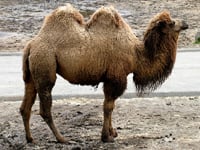

 |

|
 Bactrian Camel |
Bactrian Camel(Mammal) |
 Bactrian Camel Baby |
Bactrian Camel HabitsOnce found over a vast range in Asia, Bactrian camels now inhabit only Mongolia's remote Gobi Desert. They are specially adapted to cope with the extremes of climate found in this region. They form small groups of six to twenty animals that are led by mature male. Young males spend most of their time wandering alone.
It is thought that the Bactrian camel was domesticated by man as early as 2,000 B.C. It is presumed to be a descendant of the feral camel. At the end of the nineteenth century, Bactrian camels were discovered in the Lobnor Desert in China by the Russian explorer, Nikolai Przewalski, and it was established that, in its natural state, the Bactrian camel is truly wild, rather than domesticated, animal. The camel is also an important source of wool, milk, meat, and fuel in the desert. |
Bactrian Camel CommunicationA rutting male stretches to hold his head higher than a rival. This displays dominance.
They vocalize using a rutting cry: blo-blo-blo".
They use olfaction or scent Marking. Male rubs back of head against shoulders (occipital gland), and the secretions tend to excite males.
|
Bactrian Camel BreedingIn the wild, Bactrian camels mate in February. The males chase off young animals in order to have access to the females. Mating takes place while the camels are sitting down, but the females give birth in a standing position a year and a month later.
A single young is born. Within several days, it can walk perfectly with the ambling gait that is characteristic of the adult camel. The females nurse the young for 5 years until they reach sexual maturity. Young males are then driven out to form bachelor herds; young females remain with their mothers. Older males return to the herd during mating season but are often driven out by younger, rival males. |
Bactrian Camel Food & FeedingLike domestic cows, camels are ruminants-that is, they feed and then regurgitate the food and chew it again. This is also called chewing cud. Able to survive on extremely sparse vegetation, they eat the tough grass, herbs, thin branches, and foliage of shrubs that grow in their arid environment. They search for food in the morning and evening and chew their cud in the afternoon. The camel can tolerate great variations in its body temperature and therefore loses little water through perspiration. Although camels can go for long periods without water, they do not actually store it in their humps. The humps are, in fact, reserves of fat that are converted into water when the camel becomes dehydrated. |
Bactrian Camel Key Facts |
| Size |
| Height: Length: 11-12 ft., including tail (21-25 in. long) |
| Weight: 1,000-1,500 lbs |
| Breeding |
| Sexual maturity: 5 years |
| Mating: February |
| Gestation: About 13 months |
| Number of young: 1 calf |
| Lifestyle |
| Habit: Females live in small herds with 1 male. Other males solitary |
| Diet: Grasses and shrubs |
| Lifespan: Longest recorded, 50 years |
DID YOU KNOW?
|
CAN'T FIND WHAT YOU'RE LOOKING FOR? CLICK HERE!!!